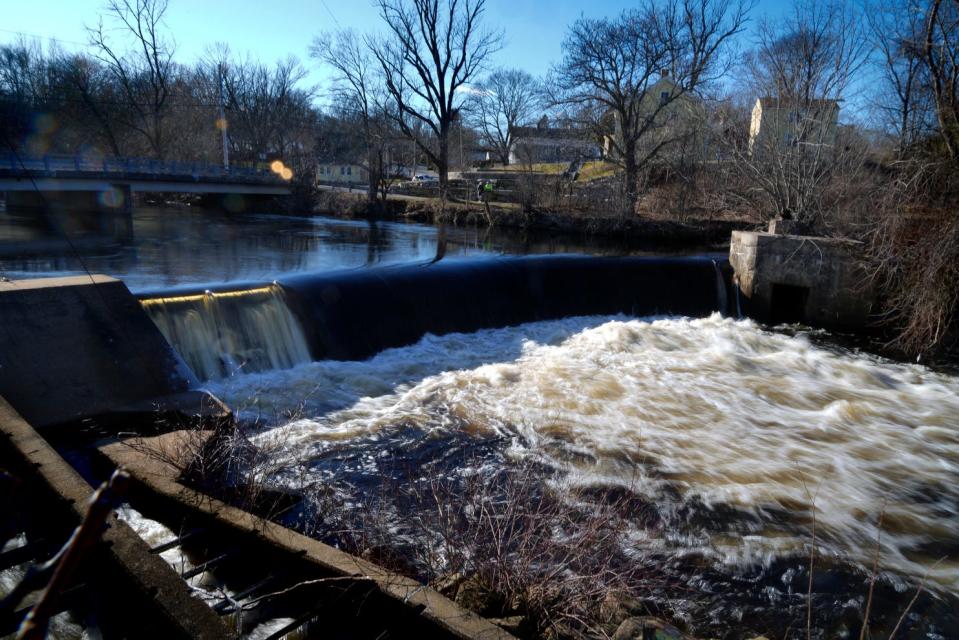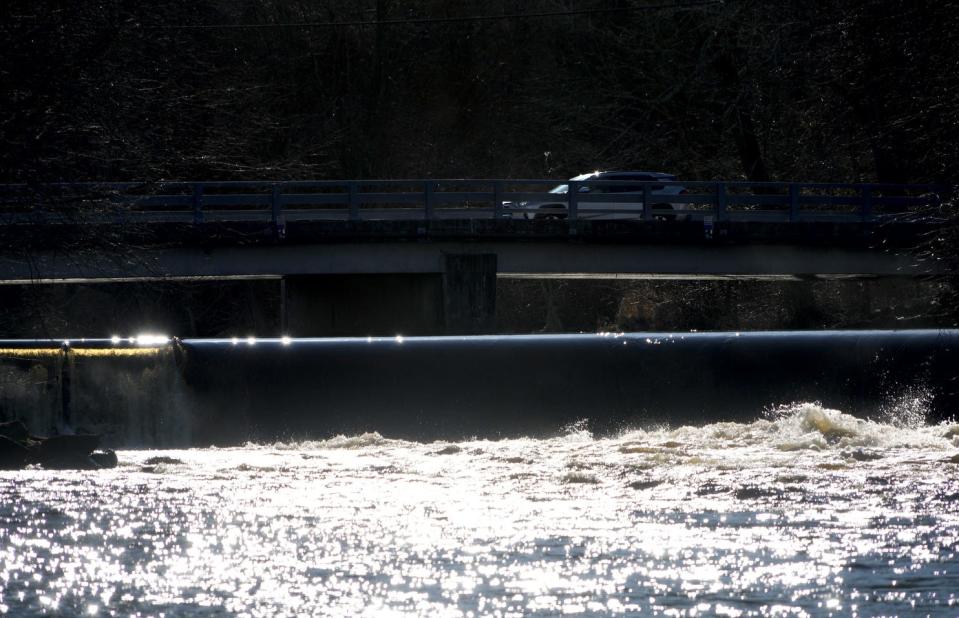'They don't want to see it change': The politics of removing a dam divides Westerly
WESTERLY – The last time that herring, shad and eels freely coursed through the Pawcatuck River, George Washington had yet to be elected president.
For hundreds of years, dams and other manmade impediments have stood in the way of their annual migration, preventing them from making their way upstream to spawn. Environmentalists have spent decades working to remove most of those roadblocks, and they are eager to get rid of the last major remaining barrier: the Potter Hill Mill Dam, which sits next to a derelict, abandoned factory at the northern edge of town.
Doing so would also lower the risk of flooding and create better conditions for canoeing and kayaking. But for several years, the idea has faced strong political headwinds: Riverfront homeowners in both Westerly and Hopkinton worry that they'll be left with foul-smelling muck, decreased property values and nowhere to use their pontoon boats if the Pawcatuck returns to its natural water levels.
"It's a noble thought to return this river to its original state, 250 years ago," James Duksta, who lives on the Hopkinton side of the river, told the Westerly Town Council in December. "However, a considerable amount of wildlife – and taxpayers – have settled in and come to call this area home since the 1780s. We need to be realistic. It is not practical to restore this area to the 1780s."

On-again off-again project has faced shifting political winds
Across the country, there's an ongoing push to remove obsolete dams and restore rivers to their wild and natural state. But those projects tend to face unusually high levels of resistance in Rhode Island, according to Christopher Fox, the director of the Wood-Pawcatuck Watershed Association.
"Being the seat of the Industrial Revolution, there’s a romanticism towards the dams that were built to power the mills that doesn’t necessarily exist in the rest of the country," he said.
The Potter Hill Mill Dam was originally constructed to power a grist mill in 1762 and was rebuilt in 1905. Then, in 1958, the wool factory that it once powered shut down. The dam no longer served a purpose, but it continued to sit there, slowly deteriorating.
Several years ago, Westerly became concerned that the dam might fail, according to Nature Conservancy spokesman Tim Mooney. The nonprofit, which has spearheaded a number of other local dam removal initiatives, worked with then-town manager Mark Rooney to obtain federal funding so that the town could look into options for removing or modifying it.
The project was a team effort involving the National Oceanic and Atmospheric Administration, the U.S. Fish & Wildlife Service, the Rhode Island Department of Environmental Management and a long list of local conservation groups. But it was also subject to shifting political winds.
In the fall of 2021, Rooney resigned, and the Westerly Town Council took on direct oversight of the project, Mooney said. By then, a small yet vocal group of riverfront homeowners and recreational boaters began rallying opposition. A few months later, the council voted to effectively kill the project.
But most of those council members were term-limited, and last year a new council brought the idea back to life. Now, several options are on the table, including partially removing the dam and adding a "nature-like fishway" to help migratory species make their way upstream.

Why proponents want the dam fully removed
Groups including Save The Bay, the Rhode Island Saltwater Anglers Association, Backcountry Hunters & Anglers, and the Narragansett Indian Tribe have made their position clear: Westerly should remove the dam altogether.
"The best outcome is to restore the river to a free-flowing state," said Michael Woods, chair of the New England chapter of Backcountry Hunters & Anglers. "It’s going to be best for the fish, for the ecosystem."
More: In Warren, a dam comes down to restore a river. How that helps wildlife and reduces flooding
The 34-mile Pawcatuck River is part of the largest watershed in Rhode Island. Fish that spawn here are an important food source for bluefish, striped bass, ospreys and herons, Woods said. Although the Potter Hill Mill Dam has a fish ladder, it doesn't work as intended: Migrating fish tend to pile up at the base, where they're preyed on by gulls and cormorants.
Getting rid of the dam would have the added benefit of making Westerly less vulnerable to flooding, according to proponents. Keeping the river dammed up means that heavy rainfall can lead to catastrophic flooding upstream. The aging dam could also fail during a major storm, creating problems downstream.
Removing the dam would also improve recreational opportunities, in Woods' view. Right now, it presents a safety hazard for paddlers, and getting around it involves a long walk along a road with no sidewalk while carrying a kayak or canoe.
Some homeowners worry that the section of the Pawcatuck that's directly upstream from the dam – and currently bears more resemblance to a pond than a river – will become too shallow and narrow for other recreational watercraft. According to engineers from Fuss & O'Neill, water levels would drop by approximately 6.8 feet if the dam is removed.
"Is my pontoon boat going to still to fit on that river? I don't think so," Kenneth Taylor, of Ashaway, told the Westerly Town Council in December. He lamented that he had spent "just about all my life savings" on his riverfront home.
Woods pointed out that it's not yet fully clear if restoring the Pawcatuck to its natural state would be detrimental to some recreational boaters. But it may be necessary to make some tradeoffs, he said: "Do we want a river that is a healthy river ecosystem, or do we want a pond?"
'They don't want to see it change'
Westerly and Hopkinton residents who live near the Potter Hill Mill Dam have raised some valid concerns about what would happen once water levels drop – for instance, the possibility that private wells could dry up. Officials have since pledged to replace any wells that are affected, at no cost.
But much of the resistance to removing the dam tends to ignore the scientific evidence. People who live along the Pawcatuck have repeatedly suggested that they're the real experts on the river and say they don't trust what they're hearing from wildlife biologists and engineers.
"We have been treated like we don't know what we’re talking about," Susan Rosen, who's lived on the Pawcatuck for 37 years, told the Westerly Town Council in December. "Those of us who live on the river or use the river for recreation know the river – not from a textbook or research data."
Opponents of the project often argue that lowering the river's water levels will actually be detrimental to the environment, since wetlands will dry up and habitat will disappear. At public meetings, scientists have repeatedly said that isn't true – very few species prefer to live in dammed-up wetlands, and many would benefit from a free-flowing river.
Another oft-repeated claim is that removing the dam will lead to more flooding downstream. Again, engineers say that's untrue, adding there's no way they'd be able to get a permit if that were the case.
Homeowners also fear that, once the river's water levels recede, they'll be stuck looking at smelly mudflats that will eventually be overrun with invasive plants. Backers of the project, however, say that invasive species shouldn't be a big problem. And it will only take one season for newly exposed soil to be replaced with vegetation, they say.
"People that live near the river, they don't want to see it change," said James Turek, a NOAA restoration ecologist who's spent more than two decades working to restore the Pawcatuck River to a more natural state. "They like it the way it looks. And the way I view these projects is that they're to benefit both the overall community in this region and the broader river and marine ecosystems."
What happens now?
After considering eight options, the Westerly Town Council voted 4-2 last Monday to select full dam removal as its top preference.
It also selected two potential alternatives to study further, both of which would involve partially removing the dam and creating a series of weirs, structures placed in the water to direct the movement of fish. Water levels would drop by either 6 feet or 3.5 feet – less than if the dam were removed entirely, but still a bigger change than many homeowners were willing to accept.
The next step is to have engineers study the feasibility of all three options. At this point, it's difficult to say which would be "the absolute best" for Westerly and Hopkinton, Fox said.
However, he pointed out, full dam removal "virtually guarantees no cost ever to the local taxpayer." In his view, it's extremely likely that federal grants would pay for the project. Building a series of weirs, on the other hand, would leave the town on the hook for future upkeep and maintenance.
"There's no guarantee that Westerly will be selected for the highly competitive NOAA grants," Turek noted. "But in most cases, both NOAA and the U.S. Fish and Wildlife Service prefer full removal of any kind of migratory fish passage barrier when they're deciding what projects to fund."
While Westerly deliberates over whether to get rid of the dam, nature may end up making the decision.
"Doing nothing might seem like the safer option for the town," Fox said. But the dam is already holding back less and less water each year due to its deteriorating condition, he pointed out. Someday, people's fears may unexpectedly become a reality, whether Westerly decides to remove it or not.
This article originally appeared on The Providence Journal: Should Westerly remove the Potter Hill Mill Dam? It's controversial

